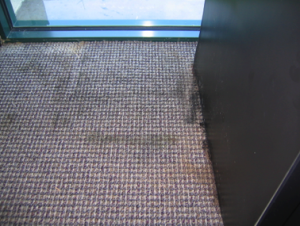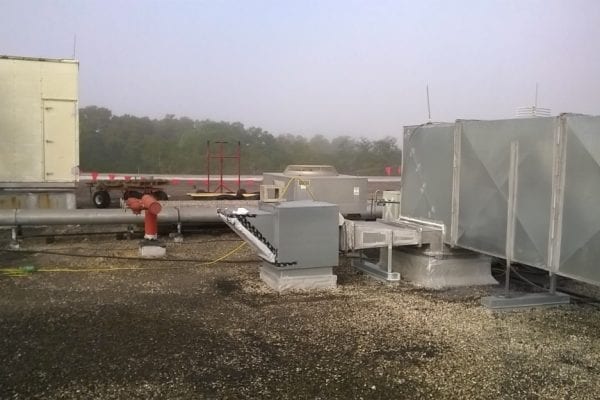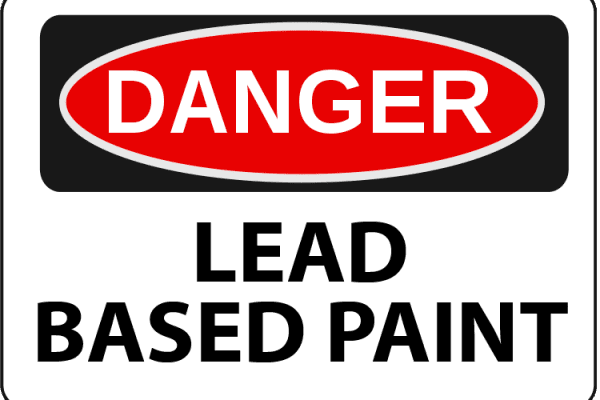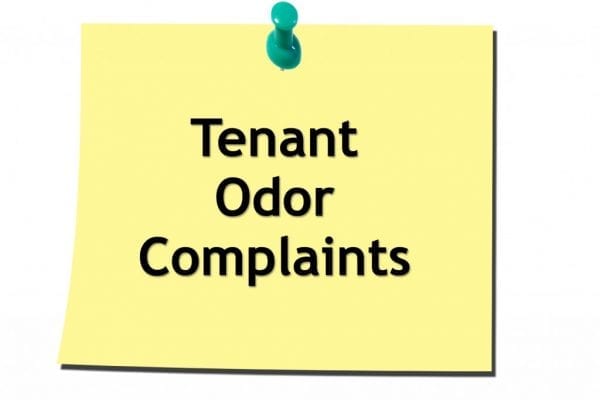Tenant complaints about indoor air quality (IAQ) can be frustrating and difficult to resolve. Whether the occupants are convinced that there’s a mold problem, or they describe headaches that seem to go away when they leave the building, air quality issues can be tough to diagnose and costly to remediate.
Because of these challenges, it may be tempting to write off complaints, or assume that the complainants are imagining things. In commercial buildings, OSHA lays much of the responsibility for a safe work environment at the feet of employers, rather than building owners, which can tempt property owners to expect tenants to deal with complaints themselves.
However, the fact that OSHA doesn’t specifically require you to provide safe working conditions for your tenant’s employees doesn’t mean you’re off the hook.
Here are three reasons you should listen carefully to indoor air quality complaints:
1. You are responsible for ensuring that the tenant has quiet enjoyment of their space, which is broadly interpreted to mean that you are responsible for setting rules and maintaining an appropriate physical environment. When the building develops a significant indoor air quality problem, the tenant has the right to expect you to address it.
2. If the problem escalates and is ultimately determined to be your responsibility, you could be liable for worker’s compensation and other costs/damages incurred by the employer while the problem continues unabated.
3. Indoor air quality problems can serve as early warning signs of building component or system breakdowns that will become much costlier later if not addressed quickly.
With that in mind, we’ve rounded up the top four indoor air quality problems our clients encounter, along with best practices for approaching each one.
Odor
Odor problems are one of the most common IAQ problems, as well as one of the most difficult to trace. They’re also one of the easiest to ignore, but you do so at your own peril. While a bad smell might seem to you a mere inconvenience, employees who have no choice but to be in the building 40 hours a week are likely to disagree. Plus, some odors indicate harmful contaminants that may lead to bigger problems down the road.
Objectionable odors can range from must and mildew, to pungent chemical smells or a strong organic stench like sewage or rotten eggs. Even scents that are commonly considered pleasant, such as perfume or air freshener, can be oppressive when not properly ventilated. In the absence of a visible carcass or a broken barrel of hydrogen sulfide, tracking down the source of such odors can be difficult, but it is a necessary first step in resolving the problem.
We start all indoor air quality investigations by interviewing tenants (individually, so they don’t cross-contaminate their testimony). For odor problems, we ask interviewees to tell us:
- How they describe the odor
- Where it seems strongest
- When it seems strongest—time of day, weather factors, time of year
- Any recent changes in the environment, such as new furniture or carpet, new adjacent tenants, new processes added to production, etc.
We use the information gathered in these interviews to guide our further investigation. If the source seems to come from inside the tenant’s space, such as new carpet, furniture, or cologne-wearing employees, the problem is usually one of improper ventilation. Improving air turnover rate will usually eliminate the problem.
In other cases, odors may be caused by an imprudently placed air handler. Perhaps the most common situation we encounter is a return air intake located inside or adjacent to a janitorial supply closet. Smells from cleaning chemicals, old musty mops, and stagnant water located in these areas can get pulled into the HVAC system and distributed throughout the building.
In another case, a tenant complained of an exhaust odor throughout a large office space. We traced the problem to an air handler located 50 feet from a small engine repair shop located in the same building. By addressing the airflow in the building, we eliminated the redistribution of exhaust into tenant offices and cleared up the problem.
Other causes include the presence of something that doesn’t belong in the building, such as a dead animal in the walls, mold contamination, or improper chemical usage. In these cases, once the source of the problem is identified, removed, and properly cleaned, the odor will usually go away on its own.
Mold
 Mold complaints are possibly the most common concern we hear from property managers. Thanks to ample media attention, tenants tend to blame a multitude of ills on suspected mold problems. Coughing, sneezing, headaches, or even just a little unexplained black dust on a desk every morning can lead to suspicions of a mold problem.
Mold complaints are possibly the most common concern we hear from property managers. Thanks to ample media attention, tenants tend to blame a multitude of ills on suspected mold problems. Coughing, sneezing, headaches, or even just a little unexplained black dust on a desk every morning can lead to suspicions of a mold problem.
For property managers, this can be frustrating, because actual mold problems can be tough to track down and difficult to distinguish from tenant hysteria. But, for all the reasons outlined in the odor section, you simply can’t afford to ignore these complaints.
Investigation begins with interviews, conducted separately, as for odors. Ask each complainant to tell you:
- Why they think there is a mold problem
- What their symptoms are, if any
- Whether they’ve seen something suspicious
- What time of day they’re experiencing symptoms or seeing evidence
- Where in the building symptoms and/or evidence are most obvious
If interviewees describe sneezing, runny noses, coughing, wheezing, and itchy eyes, there’s a good chance they’re right about the mold. Otherwise, look elsewhere for the problem (but don’t discount it entirely—flip forward to “inadequate fresh air,” discussed below, as a possible cause).
Mold requires two things to grow: Moisture, and organic matter (such as ceiling tiles, particle board, or even just accumulated debris). Look first in bathrooms and kitchen areas where moisture might accumulate. Investigate around windows and doors, where it might come in from outside. Air conditioning condensate collection pans can also be a conducive environment for mold growth. If a visual inspection turns nothing up, you may have an issue in the walls or systems of the building. In that case, it’s time to bring in a professional, if you haven’t already.
Once the problem is identified, killing the mold itself is a simple matter and can be accomplished with readily available fungicide products. However, it’s important to note that a mold problem usually indicates a structural or systems problem that must be addressed in order to prevent recurrence. It may be as simple as sealing the building envelope or fixing a plumbing leak, or it may require more significant renovations.
Inadequate Fresh Air
When tenants complain that a building is making them sick, but there are no visible clues as to the cause, frequently the problem is inadequate fresh air introduction into the HVAC system. This is especially true for older buildings that have undergone a change from their original use.
For example, we received an inquiry from the owner of a strip mall that had been converted into a call center. Call center employees had been complaining of breathing trouble inside the building, for no obvious reason. When we arrived on the scene, there was an ambulance in the parking lot treating a building tenant for an acute breathing problem.
We immediately suspected high concentration of CO2 (carbon dioxide) was causing the problems, based on the symptoms as well as the fact that the building’s systems had never been intended to serve so many occupants at once. Our suspicions were confirmed on further investigation.
The building’s HVAC had been designed to handle the cooling and ventilation needs of shoppers and retail employees, not the large number of people packed into cubicles under the building’s current use. As a result, the thermostat had been cranked to its highest level while all sources of fresh air introduction were cut off in an attempt to maintain a reasonable temperature.
Under those conditions, the CO2 that humans naturally breathe out with every breath had nowhere to go, and the oxygen that we require from fresh air had no way to get in. Inadequate fresh air had caused an invisible and potentially harmful problem that was about to become a PR nightmare for the building owner.
On the face of it, inadequate fresh air supply seems a simple problem to solve: You increase the amount of fresh air supplied to the HVAC system in the building. Of course, in large buildings nothing is ever quite so simple. In the case of the call center, the correct long-term solution was to install a properly sized HVAC system with an adequate amount of fresh air supply.
The reason supplying adequate fresh air is not a simple matter ties closely with the fourth big IAQ problem: Temperature and Humidity.
Temperature and Humidity
A building that is too hot, too cold, too humid, too dry or otherwise generally uncomfortable, can impact productivity and cause health problems. Dryness can be a fire hazard in an industrial setting where static can cause electrical arcs. High humidity can lead to mold, which comes with its own host of problems.
To get to the bottom of a temperature or humidity problem, it’s important to understand how a building’s HVAC system works. Air handlers pull fresh air from outdoors (or elsewhere in the building—which can lead to other types of IAQ problems), condition it by either heating or cooling, removing or adding water vapor, and then distribute it throughout the building. Cooling systems treat the air by running it over super-cooled coils, which simultaneously removes humidity from the air. Heating systems generally use some form of energy to heat the air and then redistribute it, which usually has less impact on its humidity—for better and for worse.
In the Southeastern United States, where heat and humidity are the norm outdoors, an undersized HVAC system can cause obvious problems, but what many building owners don’t know is that an oversized system can also cause humidity problems. When the system pulls extremely moist air into the building, and cools it so quickly that it doesn’t have time to dehumidify properly, the result is a chilly, muggy environment. Modern digital building systems often address this problem by including humidity controls in the thermostat system, but older systems must find a way to increase the amount of time air spends de-humidifying, without over-cooling. Sometimes, extra dehumidifying capacity can be added to the system to achieve the proper balance, and sometimes a more appropriately sized cooling system is called for.
In dry climates, the opposite happens in summer—dry air enters the building and is dried further by running over air conditioning coils. An undersized HVAC system will exacerbate the problem by requiring the air to remain in the de-humidification process for longer, in order to achieve the desired temperature. Under these circumstances, a humidification system is called for to avoid health problems and potential safety hazards.
Winter presents its own humidity and temperature balance problems. The key to solving these problems lies in examining your heating and cooling system, ensuring it is properly sized for your building’s use, and adjusting the amount of ventilation and humidification/dehumidification to balance temperature and humidity needs.
Conclusion
In many cases, indoor air quality problems can be solved with a little detective work and relatively minor adjustments. Other problems may require a more comprehensive and potentially costly solution. Knowing the difference requires cross-disciplinary expertise that includes not only an understanding of air quality and its symptoms, but also knowledge of building systems, construction, mechanical, electrical, and plumbing. It’s unfortunately common for building managers to hire an IAQ company and invest in costly filtration or other measures that don’t solve the problem because the IAQ folks didn’t have the expertise to understand the underlying causes. Look for a provider who can bring all areas of relevant expertise to the table to solve your problem quickly and cost effectively.
If you’re facing IAQ problems in one of your buildings, you can discuss it right now with a member of one of our multi-disciplinary teams.






